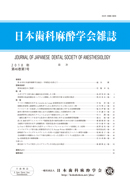Volume 46, Issue 1
Displaying 1-16 of 16 articles from this issue
- |<
- <
- 1
- >
- >|
Clinical Article
-
2018Volume 46Issue 1 Pages 1-5
Published: 2018
Released on J-STAGE: January 15, 2018
Download PDF (826K) -
2018Volume 46Issue 1 Pages 6-12
Published: 2018
Released on J-STAGE: January 15, 2018
Download PDF (860K)
Short Communication
-
2018Volume 46Issue 1 Pages 13-15
Published: 2018
Released on J-STAGE: January 15, 2018
Download PDF (967K) -
2018Volume 46Issue 1 Pages 16-18
Published: 2018
Released on J-STAGE: January 15, 2018
Download PDF (804K) -
2018Volume 46Issue 1 Pages 19-21
Published: 2018
Released on J-STAGE: January 15, 2018
Download PDF (806K) -
2018Volume 46Issue 1 Pages 22-24
Published: 2018
Released on J-STAGE: January 15, 2018
Download PDF (804K) -
2018Volume 46Issue 1 Pages 25-27
Published: 2018
Released on J-STAGE: January 15, 2018
Download PDF (1279K) -
2018Volume 46Issue 1 Pages 28-30
Published: 2018
Released on J-STAGE: January 15, 2018
Download PDF (1267K) -
2018Volume 46Issue 1 Pages 31-33
Published: 2018
Released on J-STAGE: January 15, 2018
Download PDF (806K) -
2018Volume 46Issue 1 Pages 34-36
Published: 2018
Released on J-STAGE: January 15, 2018
Download PDF (805K) -
2018Volume 46Issue 1 Pages 37-39
Published: 2018
Released on J-STAGE: January 15, 2018
Download PDF (1886K) -
2018Volume 46Issue 1 Pages 40-42
Published: 2018
Released on J-STAGE: January 15, 2018
Download PDF (806K) -
2018Volume 46Issue 1 Pages 43-45
Published: 2018
Released on J-STAGE: January 15, 2018
Download PDF (808K) -
2018Volume 46Issue 1 Pages 46-48
Published: 2018
Released on J-STAGE: January 15, 2018
Download PDF (880K) -
2018Volume 46Issue 1 Pages 49-51
Published: 2018
Released on J-STAGE: January 15, 2018
Download PDF (1284K)
Report
-
2018Volume 46Issue 1 Pages 52-54
Published: 2018
Released on J-STAGE: January 15, 2018
Download PDF (1189K)
- |<
- <
- 1
- >
- >|
